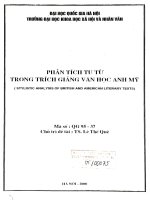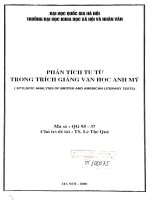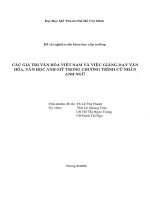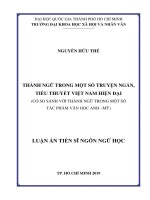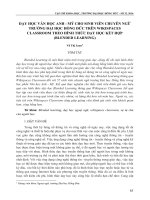En16 văn học anh mỹ bài 6
Bạn đang xem bản rút gọn của tài liệu. Xem và tải ngay bản đầy đủ của tài liệu tại đây (90.37 KB, 3 trang )
<span class="text_page_counter">Trang 1</span><div class="page_container" data-page="1">
<b>HANOI OPEN UNIVERSITYMID -TERM TEST ON ENGLISH AND AMERICANLITERATURE </b>
<small>FOR STUDENTS OF ENGLISH (No 2)</small>Subject Code: EN16
Full name: Date of birth: Group:
<b>I. Answer the following questions: (50 points )</b>
1. What three languages were spoken in England in the 11th - 13th centuries, and whom were they spoken by? Mention some reasons.
Three main languages were spoken in England in the 11th - 13th centuries: Middle English, Anglo-Norman and Latin.
<b>- Middle English: Earliest literary document in English in the University of Nottingham </b>
collection, a fragment from the life of ST Bridget, from Legend of the South of England, composed in the late 13th century. Scribes used the Anglo-Saxon letters 'yogh' for 'y' or 'g' and thorn for 'th'. He leaves a wide space between the first capital letter of each line and the rest of the word.
<b>- Anglo-Norman: Anglo-Norman emerged as a distinct dialect of French after the </b>
Norman Conquest of 1066, establishing a French-speaking aristocracy over English. It was still dominant in the mid-13th century when Robert of Gretham wrote his advice or moral conduct, Mirur. For Robert, the appropriate language for lay education was French,but by the end of the 14th century his books were translated into English.
<b>- French: John Gower, a contemporary and friend of Geoffrey Chaucer in the late </b>
fourteenth century, wrote in all three languages. His ballads include the French poem
<i>Traitie pour les amantz marietz, extolling the virtues of conjugal love. Below is the </i>
section with an introduction (highlighted in red ink) in which Gower apologizes for any errors in his French. The introduction to the passage is written in Latin and reads
<i>'Gower, ... This follows the familiar convention of bilingual presentation. Gower's great </i>
English work is known by its Latin title Confessio Amantis and includes Latin titles and section titles.
2. What is a romance, a fabliaux, a bestiaria? In what language were they written?
<b>- Romance: is a narrative genre in literature with a plot of mystery, adventure, or </b>
spirituality, in which the focus is on a quest involving courage and strong values, not
</div><span class="text_page_counter">Trang 2</span><div class="page_container" data-page="2">always love. However, modern definitions of romance also include stories that center on relationship issues.
<b>- Fabliaux: is a short lyrical story popularized in medieval France by troubadours, or </b>
professional storytellers. Fabliaux is characterized by vivid detail and realistic
observation, and is often humorous, crude, and often cynical, especially in his treatment of women.
<b>- Animals: are a collection of animals. Originating in the ancient world, bestiaries </b>
became popular in the Middle Ages in the form of illustrated volumes depicting various animals and even rocks. The natural history and illustration of each beast is often
accompanied by a moral lesson. This reflects the belief that the world itself is the Word ofGod and that every living thing has its special meaning.
<b>II. Comments (50 points ) </b>
Write what you know about the life and works of Geoffrey Chaucer - The founder of English realism
Geoffrey Chaucer (c. 1343 – 1400) was an English poet and author widely
considered the greatest English poet of the Middle Ages and is often called the "Father of English Literature". Chaucer was born around 1343, though the exact date and location are unknown. He came from a family of prosperous wine merchants with connections to the London and Ipswich courts. His most famous work is "The Canterbury Tales," a collection of stories told by a group of pilgrims as they travel on a pilgrimage from London to Canterbury to visit the shrine of Saint Thomas Becket. This work is noted for its variety in terms of both the tales themselves and the tellers of those tales, and it reflects a rich panorama of English life at the time.
Chaucer's works are crucial in English literary history for several reasons:
1. About the Language: Chaucer wrote at a time when the standard literary languages in England were still French and Latin. By writing in English, Chaucer gave prestige to the English language and its dialects and showed that they could be used for serious literary expression.
2. Realism: He is often called the founder of English realism due to his detailed
observations of people, which reflect the complexity of human nature. His characters are vivid, multifaceted, and individual, with their own voices and peculiarities.
3. Verse Form: He is credited with popularizing iambic pentameter, which has since become one of the most common verse forms in English.
</div><span class="text_page_counter">Trang 3</span><div class="page_container" data-page="3">4. Literary Techniques: His use of satire, irony, humor, and the frame narrative in "The Canterbury Tales" was innovative at the time.
5. Influence: His work influenced countless writers and poets, not only in England but also throughout Europe.
Chaucer held various positions in the English court and civil service, including being a member of Parliament, a justice of the peace, and Clerk of the King's Works. He traveled widely and was influenced by the works of contemporary Italian poets like Dante and Boccaccio.
Chaucer's work marks the transition from the medieval to the early modern period in English literature. His ability to capture the voices and experiences of a wide cross-section of society in his writing was groundbreaking and continues to be celebrated for both its artistic merit and its social commentary.
</div>


